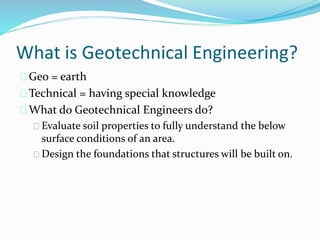The Facts About Geotheta Uncovered
The Facts About Geotheta Uncovered
Blog Article
The 7-Second Trick For Geotheta
Table of ContentsNot known Incorrect Statements About Geotheta The Only Guide to GeothetaSome Known Details About Geotheta Excitement About Geotheta
They collaborate with civil engineers, architectural engineers, designers, and other professionals to incorporate geotechnical factors to consider right into the general job layout and building and construction process. This calls for effective teamwork, coordination, and interaction to make certain that the geotechnical facets straighten with the job objectives and fulfill governing demands.Mining & Products Design: Principles of exploration, infiltration rates, and aspects affecting the option of drilling method. Qualities of nitroglycerins, firing systems and blast patterns. Blowing up methods in surface area and below ground workings. Unique blasting methods at excavation perimeters. Vibration and noise control. Mechanical and constant strategies to fragmentation, consisting of longwall shearing and fullface boring.
Modelling of fragment and particle dimension circulations; comminution as a transfer function. Comminution innovation: squashing, grinding, size category. Integrated analysis of fragmentation and comminution procedures. Offered by: Mining & Products Design.
Rumored Buzz on Geotheta
Bachelor's level programs in civil, geotechnical, geological, and ecological design normally last 4 years and include basic education training courses in English, social scientific research, and the liberal arts, in addition to programs in innovative mathematics, structural geology, and liquid mineralogy. (https://geotheta.blog.ss-blog.jp/2024-08-02?1722614750)
Geotechnical design involves the evaluation of the soil and rock conditions at a specific site, and their effects for the advancement of that website. As most structures count on the ground for support, it is without surprise that an in-depth understanding of the ground problems, and the viability of foundation systems, are important to the long-lasting security and efficiency of the structure or framework.
Being experts in the investigation of geological formations and ground behaviour, geotechnical engineers execute scientific examinations and screening to recognize the impact these geological formations may carry the layout and building of building, civil and facilities jobs. This competence is critical for the design and building and construction of buildings, roads, tunnels, dams, bridges, and water system and sewer system.
The geotechnical team at Douglas Allies consistently seek advice from architects, style designers, programmers, and builders to make recommendations on design and advancement proposals to ensure that the built structures are accordingly made for the ground problems. The style of footing systems requires to think about the weight of the structure, the ability of the ground to sustain that weight with each other with motion resistances and reliable building and construction.
The Buzz on Geotheta
This task is significantly simplified by the usage of our Douglas Map geospatial platform that makes this details easily accessible in a very easy to make use of web internet browser interface. A geotechnical designer will route the drilling of boreholes and examination pits to collect soil and various other samples, and additionally evaluate surface area attributes and ground direct exposures to develop a geotechnical model of the subsurface problems.
Depending upon the task kind and ground conditions encountered, research laboratory testing may to name a few points assess stamina, compressibility, reactivity and/or leaks in the straight from the source structure of dirt and rock examples. Hereafter data is gathered and collected, the results are made use of for a geotechnical model of the site, which is usually provided as sections across the site.

A geotechnical investigation by nature can just evaluate the ground conditions at the places drilled or dug deep into. Natural variants in dirt and rock problems can take place across a website and in between examination locations. It is consequently great practice that the geotechnical engineer be kept throughout construction of the task to provide on-site verification that the ground problems experienced follow the assumptions and suggestions provided in the geotechnical investigation report.
The Ultimate Guide To Geotheta
Geotechnical engineers utilize their comprehensive expertise of dirt and rock to analyze threat and solve issues on diverse facilities projectsGeotechnical engineering is a specialist branch of civil engineering which takes a look at the behavior of earth materials and the application of soil and rock mechanics. Consulting Engineers. As a geotechnical designer, you will certainly evaluate the physical, mechanical and chemical properties of soil and rock in order to create foundations, maintaining frameworks and earthworks
Geotechnical design is closely linked to and overlaps with, both design geology and ground design - https://www.goodreads.com/user/show/180594840-ian-hammond. It's feasible to be experts in geotechnics or benefit a geotechnical company however be called an engineering rock hound or a ground engineer. As a geotechnical designer, you'll need to: construct and keep partnerships with clients and various other specialists associated with the website, throughout each projectmaintain security standards on site bear in mind cost implications when you make recommendationsstudy geological maps and aerial photos from a variety of sources and from various time periodsexamine building intends to see how practical they are based upon your understanding of the siteinvestigate risks or geological hazards for the sitesearch for environmentally delicate functions, such as landfill start to create accurate and expository ground modelsplan area investigationsdrill and evaluate samples of bedrock, soil, groundwater and added products oversee various other professionals on sitesolve technical problems as they emerge, such as unexpected structures at drill sitesmonitor problems during and after construction to ensure frameworks are stable in the brief and long termadding information collected on website to your first researchcreating geotechnical estimations, drawings, and 2 or three-dimensional computer versions translating the datamaking suggestions about the proposed use of the site

Report this page